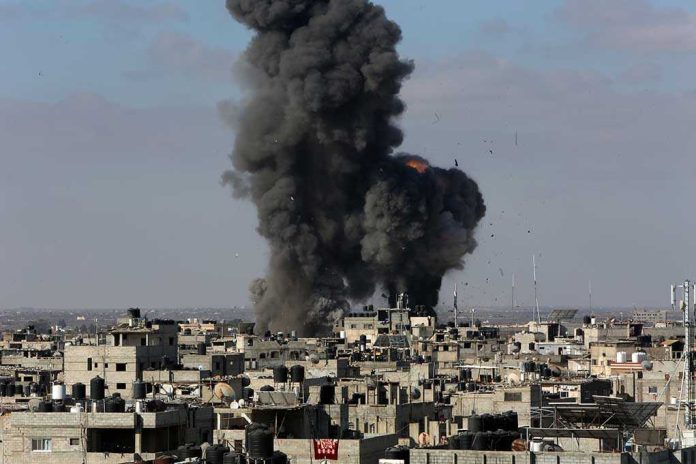
Gaza’s war has shattered the very systems that sustain life, leaving millions to confront poisoned water, a collapsed grid, and an environmental disaster that few imagined possible.
Story Snapshot
- Gaza’s water and energy infrastructure has been systematically destroyed, pushing the region into environmental and humanitarian collapse.
- Millions now lack access to safe water, sanitation, and reliable electricity; disease and displacement are rampant.
- Experts warn the deliberate targeting of essential systems has created unprecedented threats to public health and recovery.
- International agencies call for urgent restoration as rebuilding costs soar and the crisis deepens.
Environmental Collapse in Gaza: Unprecedented Scale and Impact
Before October 2023, Gaza’s environmental stress was already severe—95% of its water was undrinkable, and chronic energy shortages plagued daily life. The region’s sole aquifer had been relentlessly overexploited, leaving contamination and scarcity as grim constants. Yet the war that erupted after Hamas’s attack and Israel’s sweeping response transformed a dire situation into catastrophe. Israeli airstrikes and siege tactics targeted water and energy infrastructure, slashing water access by 95% and decimating up to 69% of vital systems. The destruction was not incidental; reports from Oxfam, Doctors Without Borders, and the Arava Institute detail how water and energy have become weapons of war, exacerbating civilian suffering and crippling Gaza’s ability to recover.
Poisoned water and shattered grid: Gaza left in environmental freefall after war, report says https://t.co/PlPs8lfxjT
— The Independent (@Independent) October 16, 2025
March 2024 marked another turning point. Aid and electricity were cut further, and desalination output plunged by 85%. By June, the United Nations Environment Programme and GRID-Arendal released a rapid environmental impact assessment, painting a stark picture: water production had fallen below 5% of normal output, with over half of Gaza’s water infrastructure destroyed or damaged. Humanitarian agencies warned of imminent disease outbreaks as fuel and aid remained largely blocked. Over 1.9 million Gazans were displaced, overwhelming the south and making basic survival a daily struggle. These figures were corroborated across authoritative field assessments, signaling not just a humanitarian disaster but a systemic collapse with no precedent in the region’s history.
Humanitarian Disaster and Public Health Emergency
Public health in Gaza now teeters on the brink. The collapse of water, sanitation, and energy systems has triggered acute outbreaks of waterborne diseases like cholera and typhoid. Doctors Without Borders reports that more than a quarter of the population faces severe illness as a direct result of drinking unsafe water and living without adequate sanitation. The impact is felt most by children, the elderly, and displaced families crammed into overcrowded shelters. Oxfam and MSF have documented how systematic targeting of water infrastructure and obstruction of humanitarian response have compounded suffering. International agencies urgently call for restoration of aid and utilities, warning that without intervention, disease and death will escalate and long-term recovery will slip further out of reach.
Rebuilding is an almost unimaginable challenge. The estimated cost exceeds $70 billion, with economic collapse and loss of livelihoods spreading across the territory. Social fragmentation grows as displacement and trauma reshape communities, and political instability deepens in the face of ongoing siege and legal battles playing out in international courts. Reports from UN agencies, Oxfam, and Arava Institute underscore that the environmental collapse is not just a technical problem—it is a crisis with profound economic, social, and political consequences, threatening Gaza’s future stability and the broader region.
Poisoned water and shattered grid: Gaza left in environmental freefall after war, report says https://t.co/2j7DpfbowC
— Fahmi Al-Husseini فهمي الحسيني (@fahmih1956) October 16, 2025
Deliberate Targeting and Power Dynamics
The power dynamics underlying Gaza’s environmental freefall are stark. Israel controls borders, resources, and the flow of aid, wielding decisive influence over the territory’s fate. Palestinian authorities and Hamas retain only limited capacity to respond under siege, while NGOs and UN agencies operate in a landscape fraught with restrictions and danger. Decision-makers include the Israeli government, military command, international bodies like the UN and ICJ, and NGO leadership. Experts from the Arava Institute and CSIS highlight how the use of water and energy as weapons of war has compounded Gaza’s chronic vulnerabilities, turning infrastructure into both a casualty and a tool of conflict. The systematic destruction has left the humanitarian sector overwhelmed and obstructed, with peace-building efforts set back for years to come.
Industry experts are unequivocal. David Lehrer of the Arava Institute observes that Gaza’s environmental and humanitarian challenges were already dire prior to the war, but the conflict has compounded every problem exponentially. Oxfam accuses Israel of weaponizing water with “disregard for human life,” while MSF describes the suffering as worsened by the crisis—many are forced to drink dangerous water, and others lack enough to survive. UNEP’s assessment finds 57% of water infrastructure destroyed and the entire WASH system collapsed. CSIS analysts argue that restoring water access is essential not only for immediate survival but for rebuilding a secure and sustainable future once the conflict ceases.
Sources:
Doctors Without Borders: Water being used as weapon of war in Gaza
TIME: Environmental impact of war in Gaza
UN/GRID-Arendal: Environmental Impact Assessment
Oxfam: Israel using water as weapon of war in Gaza
Human Rights Watch: Extermination and Acts of Genocide in Gaza
United Nations News: Gaza Water Crisis and Humanitarian Warnings















